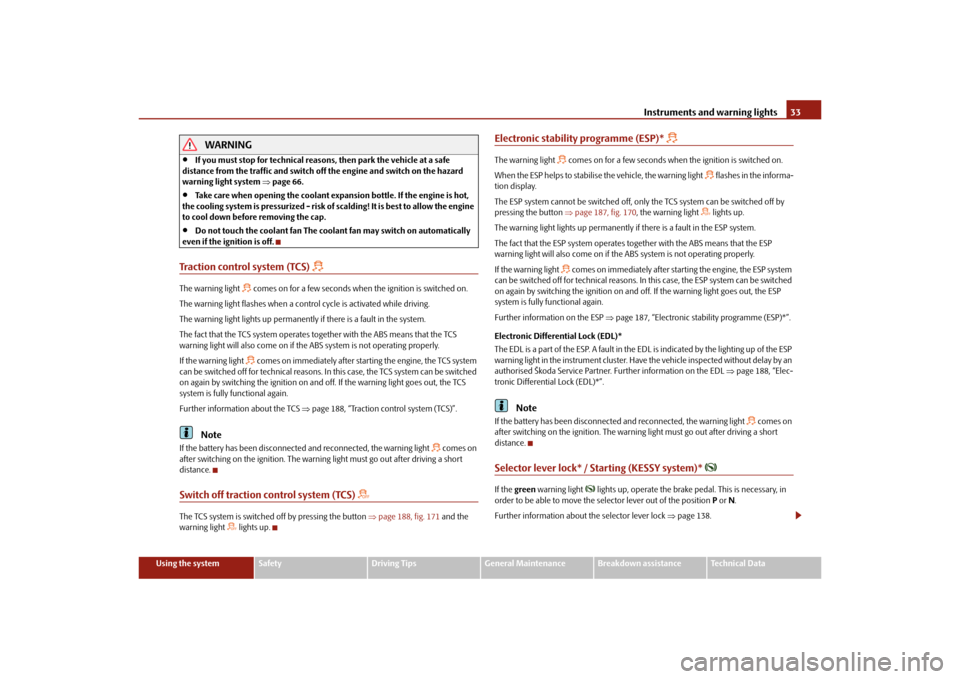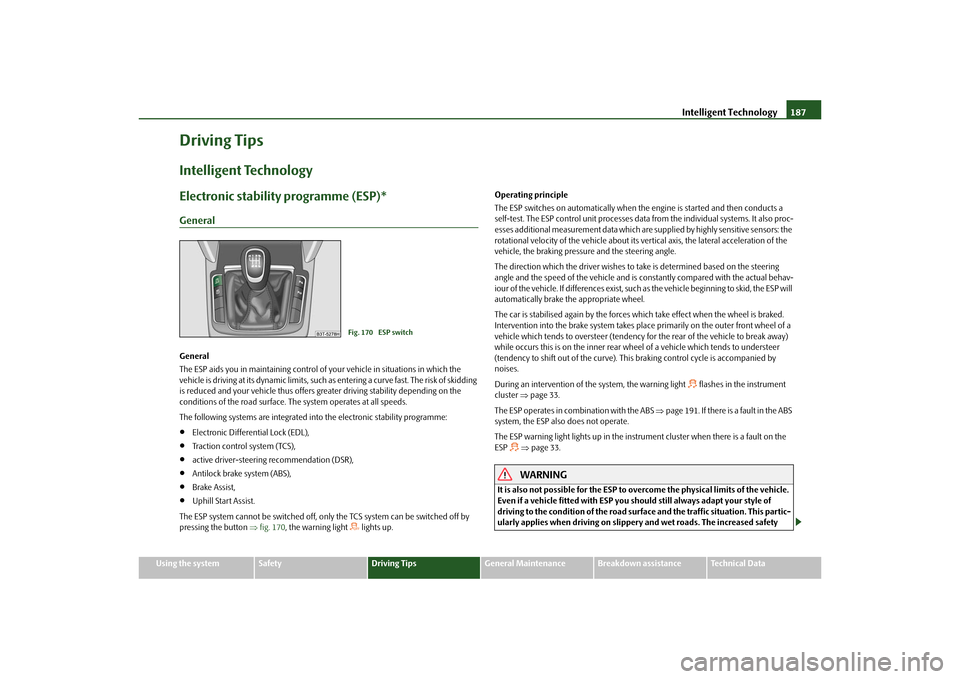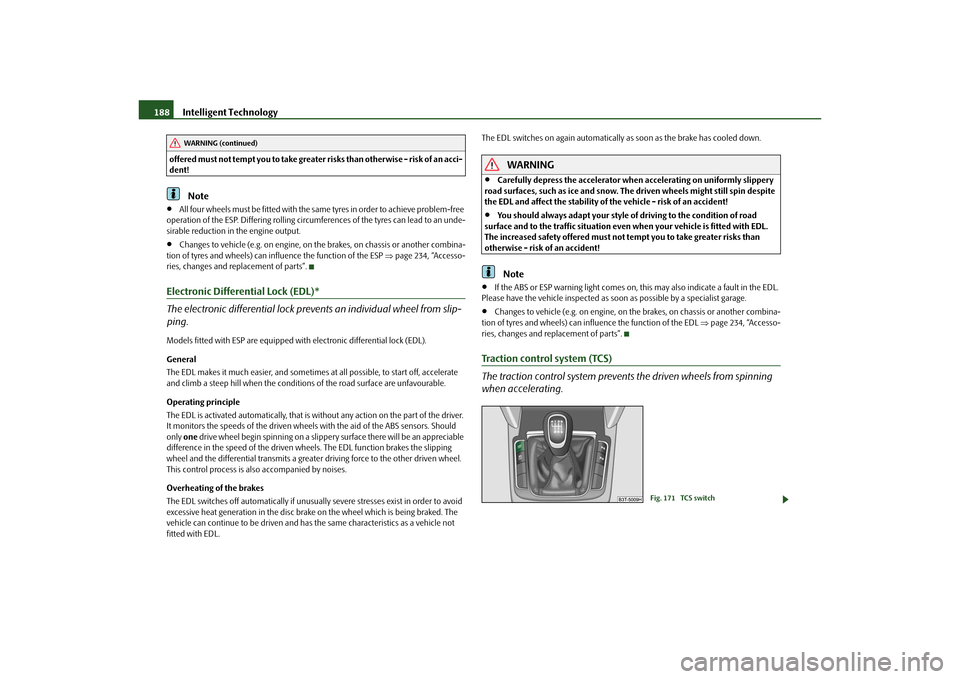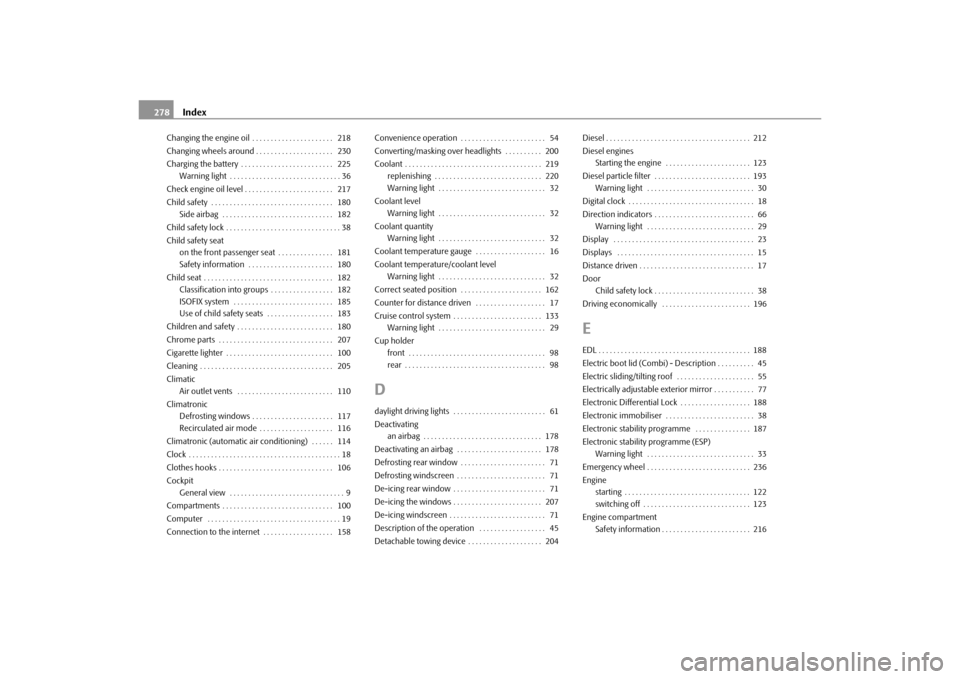differential SKODA SUPERB 2010 2.G / (B6/3T) Owner's Manual
[x] Cancel search | Manufacturer: SKODA, Model Year: 2010, Model line: SUPERB, Model: SKODA SUPERB 2010 2.G / (B6/3T)Pages: 287, PDF Size: 16.59 MB
Page 34 of 287

Instruments and warning lights33
Using the system
Safety
Driving Tips
General Maintenance
Breakdown assistance
Technical Data
WARNING
If you must stop for technical reasons, then park the vehicle at a safe
distance from the traffic and switch off the engine and switch on the hazard
warning light system page 66.
Take care when opening the coolant expa nsion bottle. If the engine is hot,
the cooling system is pressurized - risk of scalding! It is best to allow the engine
to cool down before removing the cap.
Do not touch the coolant fan The coolant fan may switch on automatically
even if the ignition is off.
Traction control system (TCS)
The warning light
comes on for a few seconds when the ignition is switched on.
The warning light flashes when a control cycle is activated while driving.
The warning light lights up permanentl y if there is a fault in the system.
The fact that the TCS system operates together with the ABS means that the TCS
warning light will also come on if the ABS system is not operating properly.
If the warning light comes on immediately after starting the engine, the TCS system
can be switched off for technical reasons. In this case, the TCS system can be switched
on again by switching the ignition on and off. If the warning light goes out, the TCS
system is fully functional again.
Further information about the TCS page 188, “Traction control system (TCS)”.
Note
If the battery has been disconnected and reconnected, the warning light
comes on
after switching on the ignition. The warning light must go out after driving a short
distance.
Switch off traction control system (TCS)
The TCS system is switched off by pressing the button page 188, fig. 171 and the
warning light
lights up.
Electronic stability programme (ESP)*
The warning light
comes on for a few seconds when the ignition is switched on.
When the ESP helps to stabilise the vehicle, the warning light
flashes in the informa-
tion display.
The ESP system cannot be switched off, only the TCS system can be switched off by
pressing the button page 187, fig. 170, the warning light
lights up.
The warning light lights up permanently if there is a fault in the ESP system.
The fact that the ESP system operates together with the ABS means that the ESP
warning light will also come on if the ABS system is not operating properly.
If the warning light
comes on immediately after starting the engine, the ESP system
can be switched off for technical reasons. In this case, the ESP system can be switched
on again by switching the igni tion on and off. If the warning light goes out, the ESP
system is fully functional again.
Further information on the ESP page 187, “Electronic stability programme (ESP)*”.
Electronic Differential Lock (EDL)*
The EDL is a part of the ESP. A fault in the ED L is indicated by the lighting up of the ESP
warning light in the instrument cluster. Have the vehicle inspected without delay by an
authorised Škoda Service Partner. Further information on the EDL page 188, “Elec-
tronic Differential Lock (EDL)*”.
Note
If the battery has been disconnected and reconnected, the warning light
comes on
after switching on the ignition. The warning light must go out after driving a short
distance.
Selector lever lock* / St arting (KESSY system)*
If the green warning light
lights up, operate the brake pedal. This is necessary, in
order to be able to move the selector lever out of the position P or N.
Further information about the selector lever lock page 138.
s3fg.2.book Page 33 Friday, April 30, 2010 12:17 PM
Page 188 of 287

Intelligent Technology187
Using the system
Safety
Driving Tips
General Maintenance
Breakdown assistance
Technical Data
Driving TipsIntelligent TechnologyElectronic stability programme (ESP)*GeneralGeneral
The ESP aids you in maintaining control of your vehicle in situations in which the
vehicle is driving at its dynamic limits, such as entering a curve fast. The risk of skidding
is reduced and your vehicle thus offers greater driving stability depending on the
conditions of the road surface. The system operates at all speeds.
The following systems are integrated into the electronic stability programme:
Electronic Differential Lock (EDL),
Traction control system (TCS),
active driver-steering recommendation (DSR),
Antilock brake system (ABS),
Brake Assist,
Uphill Start Assist.
The ESP system cannot be switched off, only the TCS system can be switched off by
pressing the button fig. 170 , the warning light
lights up. Operating principle
The ESP switches on automatically when the engine is started and then conducts a
self-test. The ESP control unit processes data from the individual systems. It also proc-
esses additional measurement data which are supplied by highly sensitive sensors: the
rotational velocity of the vehicle about its ve
rtical axis, the lateral acceleration of the
vehicle, the braking pressure and the steering angle.
The direction which the driver wishes to take is determined based on the steering
angle and the speed of the vehicle and is co nstantly compared with the actual behav-
iour of the vehicle. If differences exist, such as the vehi cle beginning to skid, the ESP will
automatically brake the appropriate wheel.
The car is stabilised again by the forces wh ich take effect when the wheel is braked.
Intervention into the brake system takes place primarily on the outer front wheel of a
vehicle which tends to oversteer (tendency for the rear of the vehicle to break away)
while occurs this is on the inner rear wh eel of a vehicle which tends to understeer
(tendency to shift out of the curve). This braking control cycle is accompanied by
noises.
During an intervention of the system, the warning light
flashes in the instrument
cluster page 33.
The ESP operates in combination with the ABS page 191. If there is a fault in the ABS
system, the ESP also does not operate.
The ESP warning light lights up in the instrument cluster when there is a fault on the
ESP
page 33.WARNING
It is also not possible for the ESP to overcome the physical limits of the vehicle.
Even if a vehicle fitted with ESP you should still always adapt your style of
driving to the condition of the road surfac e and the traffic situation. This partic-
ularly applies when driving on slippery and wet roads. The increased safety
Fig. 170 ESP switch
s3fg.2.book Page 187 Friday, April 30, 2010 12:17 PM
Page 189 of 287

Intelligent Technology
188
offered must not tempt you to take greater risks than otherwise - risk of an acci-
dent!
Note
All four wheels must be fitted with the same tyres in order to achieve problem-free
operation of the ESP. Differing rolling circum ferences of the tyres can lead to an unde-
sirable reduction in the engine output.
Changes to vehicle (e.g. on engine, on th e brakes, on chassis or another combina-
tion of tyres and wheels) can influence the function of the ESP page 234, “Accesso-
ries, changes and replacement of parts”.
Electronic Differential Lock (EDL)*
The electronic differential lock prev ents an individual wheel from slip-
ping.Models fitted with ESP ar e equipped with electronic differential lock (EDL).
General
The EDL makes it much easier, and sometimes at all possible, to start off, accelerate
and climb a steep hill when the conditions of the road surface are unfavourable.
Operating principle
The EDL is activated automaticall y, that is without any action on the part of the driver.
It monitors the speeds of the driven wheels with the aid of the ABS sensors. Should
only one drive wheel begin spinning on a slippery surface there will be an appreciable
difference in the speed of the driven wheels. The EDL function brakes the slipping
wheel and the differential transmits a greate r driving force to the other driven wheel.
This control process is also accompanied by noises.
Overheating of the brakes
The EDL switches off automatica lly if unusually severe stresses exist in order to avoid
excessive heat generation in the disc brake on the wheel which is being braked. The
vehicle can continue to be driven and has the same characteristics as a vehicle not
fitted with EDL. The EDL switches on again automatically
as soon as the brake has cooled down.
WARNING
Carefully depress the accelerator when accelerating on uniformly slippery
road surfaces, such as ice and snow. Th e driven wheels might still spin despite
the EDL and affect the stability of the vehicle - risk of an accident!
You should always adapt your style of driving to the condition of road
surface and to the traffic situation even when your vehicle is fitted with EDL.
The increased safety offered must not tempt you to take greater risks than
otherwise - risk of an accident!Note
If the ABS or ESP warning light comes on, this may also indicate a fault in the EDL.
Please have the vehicle inspected as soon as possible by a specialist garage.
Changes to vehicle (e.g. on engine, on the brakes, on chassis or another combina-
tion of tyres and wheels) can influence the function of the EDL page 234, “Accesso-
ries, changes and replacement of parts”.
Traction control system (TCS)
The traction control system prevents the driven wheels from spinning
when accelerating.
WARNING (continued)
Fig. 171 TCS switch
s3fg.2.book Page 188 Friday, April 30, 2010 12:17 PM
Page 279 of 287

Index
278
Changing the engine oil . . . . . . . . . . . . . . . . . . . . . . 218
Changing wheels around . . . . . . . . . . . . . . . . . . . . . 230
Charging the battery . . . . . . . . . . . . . . . . . . . . . . . . . 225
Warning light . . . . . . . . . . . . . . . . . . . . . . . . . . . . . . 36
Check engine oil level . . . . . . . . . . . . . . . . . . . . . . . . 217
Child safety . . . . . . . . . . . . . . . . . . . . . . . . . . . . . . . . . 180 Side airbag . . . . . . . . . . . . . . . . . . . . . . . . . . . . . . 182
Child safety lock . . . . . . . . . . . . . . . . . . . . . . . . . . . . . . . 38
Child safety seat on the front passenger seat . . . . . . . . . . . . . . . 181
Safety information . . . . . . . . . . . . . . . . . . . . . . . 180
Child seat . . . . . . . . . . . . . . . . . . . . . . . . . . . . . . . . . . . 182 Classification into groups . . . . . . . . . . . . . . . . . 182
ISOFIX system . . . . . . . . . . . . . . . . . . . . . . . . . . . 185
Use of child safety seats . . . . . . . . . . . . . . . . . . 183
Children and safety . . . . . . . . . . . . . . . . . . . . . . . . . . 180
Chrome parts . . . . . . . . . . . . . . . . . . . . . . . . . . . . . . . 207
Cigarette lighter . . . . . . . . . . . . . . . . . . . . . . . . . . . . . 100
Cleaning . . . . . . . . . . . . . . . . . . . . . . . . . . . . . . . . . . . . 205
Climatic Air outlet vents . . . . . . . . . . . . . . . . . . . . . . . . . . 110
Climatronic Defrosting windows . . . . . . . . . . . . . . . . . . . . . . 117
Recirculated air mode . . . . . . . . . . . . . . . . . . . . 116
Climatronic (automat ic air conditioning) . . . . . . 114
Clock . . . . . . . . . . . . . . . . . . . . . . . . . . . . . . . . . . . . . . . . . 18
Clothes hooks . . . . . . . . . . . . . . . . . . . . . . . . . . . . . . . 106
Cockpit General view . . . . . . . . . . . . . . . . . . . . . . . . . . . . . . . 9
Compartments . . . . . . . . . . . . . . . . . . . . . . . . . . . . . . 100
Computer . . . . . . . . . . . . . . . . . . . . . . . . . . . . . . . . . . . . 19
Connection to the internet . . . . . . . . . . . . . . . . . . . 158 Convenience operation . . . . . . . . . . . . . . . . . . . . . . . 54
Converting/masking over headlights . . . . . . . . . . 200
Coolant . . . . . . . . . . . . . . . . . . . . . . . . . . . . . . . . . . . . . 219
replenishing . . . . . . . . . . . . . . . . . . . . . . . . . . . . . 220
Warning light . . . . . . . . . . . . . . . . . . . . . . . . . . . . . 32
Coolant level Warning light . . . . . . . . . . . . . . . . . . . . . . . . . . . . . 32
Coolant quantity Warning light . . . . . . . . . . . . . . . . . . . . . . . . . . . . . 32
Coolant temperature gauge . . . . . . . . . . . . . . . . . . . 16
Coolant temperature/coolant level Warning light . . . . . . . . . . . . . . . . . . . . . . . . . . . . . 32
Correct seated position . . . . . . . . . . . . . . . . . . . . . . 162
Counter for distance driven . . . . . . . . . . . . . . . . . . . 17
Cruise control system . . . . . . . . . . . . . . . . . . . . . . . . 133 Warning light . . . . . . . . . . . . . . . . . . . . . . . . . . . . . 29
Cup holder front . . . . . . . . . . . . . . . . . . . . . . . . . . . . . . . . . . . . . 98
rear . . . . . . . . . . . . . . . . . . . . . . . . . . . . . . . . . . . . . . 98
Ddaylight driving lights . . . . . . . . . . . . . . . . . . . . . . . . . 61
Deactivatingan airbag . . . . . . . . . . . . . . . . . . . . . . . . . . . . . . . . 178
Deactivating an airbag . . . . . . . . . . . . . . . . . . . . . . . 178
Defrosting rear window . . . . . . . . . . . . . . . . . . . . . . . 71
Defrosting windscreen . . . . . . . . . . . . . . . . . . . . . . . . 71
De-icing rear window . . . . . . . . . . . . . . . . . . . . . . . . . 71
De-icing the windows . . . . . . . . . . . . . . . . . . . . . . . . 207
De-icing windscreen . . . . . . . . . . . . . . . . . . . . . . . . . . 71
Description of the operation . . . . . . . . . . . . . . . . . . 45
Detachable towing device . . . . . . . . . . . . . . . . . . . . 204 Diesel . . . . . . . . . . . . . . . . . . . . . . . . . . . . . . . . . . . . . . . 212
Diesel engines
Starting the engine . . . . . . . . . . . . . . . . . . . . . . . 123
Diesel particle filter . . . . . . . . . . . . . . . . . . . . . . . . . . 193 Warning light . . . . . . . . . . . . . . . . . . . . . . . . . . . . . 30
Digital clock . . . . . . . . . . . . . . . . . . . . . . . . . . . . . . . . . . 18
Direction indicators . . . . . . . . . . . . . . . . . . . . . . . . . . . 66 Warning light . . . . . . . . . . . . . . . . . . . . . . . . . . . . . 29
Display . . . . . . . . . . . . . . . . . . . . . . . . . . . . . . . . . . . . . . 23
Displays . . . . . . . . . . . . . . . . . . . . . . . . . . . . . . . . . . . . . 15
Distance driven . . . . . . . . . . . . . . . . . . . . . . . . . . . . . . . 17
Door Child safety lock . . . . . . . . . . . . . . . . . . . . . . . . . . . 38
Driving economically . . . . . . . . . . . . . . . . . . . . . . . . 196
EEDL . . . . . . . . . . . . . . . . . . . . . . . . . . . . . . . . . . . . . . . . . 188
Electric boot lid (Combi) - Description . . . . . . . . . . 45
Electric sliding/tilting roof . . . . . . . . . . . . . . . . . . . . . 55
Electrically adjustable exterior mirror . . . . . . . . . . . 77
Electronic Differential Lock . . . . . . . . . . . . . . . . . . . 188
Electronic immobiliser . . . . . . . . . . . . . . . . . . . . . . . . 38
Electronic stability programme . . . . . . . . . . . . . . . 187
Electronic stability programme (ESP) Warning light . . . . . . . . . . . . . . . . . . . . . . . . . . . . . 33
Emergency wheel . . . . . . . . . . . . . . . . . . . . . . . . . . . . 236
Engine starting . . . . . . . . . . . . . . . . . . . . . . . . . . . . . . . . . . 122
switching off . . . . . . . . . . . . . . . . . . . . . . . . . . . . . 123
Engine compartment Safety information . . . . . . . . . . . . . . . . . . . . . . . . 216
s3fg.2.book Page 278 Friday, April 30, 2010 12:17 PM